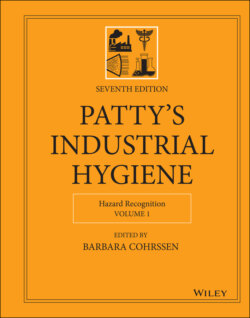Читать книгу Patty's Industrial Hygiene, Hazard Recognition - Группа авторов - Страница 37
4.6 Indoor Air Quality
ОглавлениеIndoor air quality became more prevalent as more jobs transitioned from being more agricultural to more indoor operations. It is estimated that people spend 90% of their time in indoor environments, such as residential and office buildings, schools, transportation vehicles, and workplaces (68). Indoor air quality can have an impact on health and quality of life through health hazards from chemicals such as volatile organic compounds (VOCs), tobacco smoke, formaldehyde, particulate matter, and ozone. Combustion and burning of biomass products, including wood, leaves, and animal dung used for cooking and heating in many developing countries have led to poor indoor air quality and respiratory effects (69). Indoor air quality problems can be exceedingly complex and it can be a challenge to find acceptable solutions. Attention to “toxic mold” issues in the early 2000s contributed to increased attention to much more substantial nosocomial infection risks in US health care facilities. Occupational hygienists with specialized expertise may be needed to assess and address indoor air quality issues that are related to chemical or biological contamination, and such professionals may additionally need to be familiar with specific mold evaluation and remediation procedures within specific built environments.
